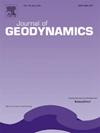The Varillar Basin: An example of basement-involved tectonism in the Central Andes of northern Chile
IF 2.1
3区 地球科学
Q2 GEOCHEMISTRY & GEOPHYSICS
引用次数: 0
Abstract
The Frontal Cordillera in the Central Andes of northern Chile is a basement-involved fold-and-thrust belt characterized by large ranges composed of Paleozoic crystalline rocks, and intermontane contractional basins that have recorded much of the Mesozoic to Cenozoic deformation history of the orogen. At the core of the Frontal Cordillera, along the transition zone between the normal and flat-slab subduction segments, the Varillar Basin serves as a natural laboratory for studying the styles and mechanisms of basement-involved deformation resulting from Andean orogenesis. In this study, we present a novel structural analysis of the basement-involved structures present in this basin by combining field and seismic data with balanced and restored cross-sections. On the surface, the dominant structural features include NNE-striking basement-cored anticlines associated with steeply east and west-dipping reverse faults. These faults uplifted and exhumed large Paleozoic blocks, which are interpreted to be the pre-rift basement for Late Permian to Jurassic rift-related basins. The available seismic line revealed the existence of partially inverted half-graben structures beneath the basin, suggesting that the tectonic inversion of preexisting normal faults is responsible for the basement-involved deformation. This is further evidenced by the occurrence of folded Triassic and Jurassic syn-rift strata, which have been partially expelled from their original depocenters and are now elevated nearly 3 km above their regional datum. Restoration of three cross-sections to their pre-shortening state indicates that steeply dipping reverse faults (e.g., Varillar and Cerro Guerrita faults) accommodated approximately 3 km of crustal shortening on average. Some of these faults have also truncated and overthrust inverted normal faults (e.g., Border Fault), resulting in complex structural arrays. While the exact timing of basement-involved deformation remains uncertain, previous K-Ar age determinations of synorogenic strata suggest that the contractional structures were active during the Paleocene. However, other previously reported low-temperature thermochronological data (apatite fission track) from surrounding areas indicate an Eocene age for the basement-involved tectonism of the Frontal Cordillera.
瓦里拉尔盆地:智利北部安第斯山脉中部与基底有关的构造运动的一个例子
智利北部安第斯山脉中部的锋面科迪勒拉是一个基底卷入的褶皱冲断带,其特征是由古生代大范围结晶岩和山间收缩盆地组成,记录了造山带中生代至新生代的大部分变形历史。Varillar盆地位于前缘科迪勒拉的核心,位于正常和平板俯冲段之间的过渡地带,是研究安第斯造山作用导致的基底变形样式和机制的天然实验室。在这项研究中,我们通过结合野外和地震资料以及平衡和恢复的截面,对该盆地存在的基底相关构造进行了新的结构分析。在地表上,主要的构造特征是北北东向基底核背斜,并伴有陡峭的东、西倾逆断层。这些断裂隆升并挖出了古生代大块块体,被解释为晚二叠世至侏罗纪裂谷相关盆地的裂陷前基底。现有地震线显示,盆地下方存在部分倒转的半地堑构造,表明原有正断层的构造倒转是基底变形的主要原因。褶皱的三叠纪和侏罗纪同裂谷地层的出现进一步证明了这一点,这些地层已部分从其原始沉积中心排出,现在比其区域基准面高出近3 km。3条断面恢复到缩短前状态,表明陡倾逆断层(如Varillar断裂和Cerro Guerrita断裂)平均可使地壳缩短约3 km。其中一些断层还具有截断逆冲逆正断层(如边界断层),形成复杂的构造阵列。虽然与基底有关的变形的确切时间仍不确定,但先前对同造地层的K-Ar年龄测定表明,收缩构造在古新世期间活跃。然而,其他先前报道的来自周围地区的低温热年代学数据(磷灰石裂变径迹)表明,前缘科迪勒拉的基底构造活动发生在始新世。
本文章由计算机程序翻译,如有差异,请以英文原文为准。
求助全文
约1分钟内获得全文
求助全文
来源期刊

Journal of Geodynamics
地学-地球化学与地球物理
CiteScore
4.60
自引率
0.00%
发文量
21
审稿时长
6-12 weeks
期刊介绍:
The Journal of Geodynamics is an international and interdisciplinary forum for the publication of results and discussions of solid earth research in geodetic, geophysical, geological and geochemical geodynamics, with special emphasis on the large scale processes involved.
 求助内容:
求助内容: 应助结果提醒方式:
应助结果提醒方式:


